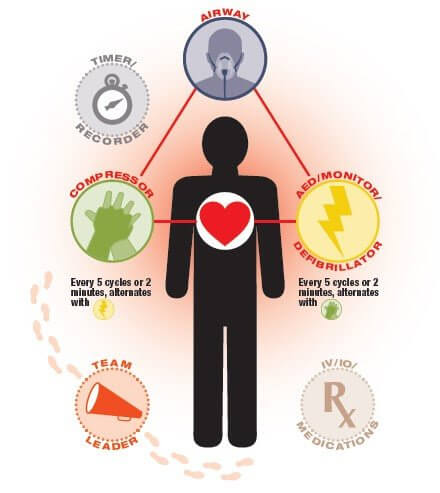3.2 Team-Based Resuscitation in a Clinical Setting
When additional rescuers arrive, CPR transitions from a two-rescuer approach to a fully coordinated team-based resuscitation. This allows for greater efficiency, reduced rescuer fatigue, and improved patient outcomes.
Why Team-Based CPR Improves Outcomes
- Clear role assignments: Each rescuer focuses on a specific task, minimizing confusion.
- More efficient compressions and ventilations: Dedicated roles ensure better coordination and timing.
- Reduces rescuer fatigue: With more responders, rescuers can rotate tasks while maintaining high-quality CPR.
Key Roles in Team-Based Resuscitation
A well-functioning team operates like a pit crew, with each member assigned a critical role:
- Compressor: Performs high-quality chest compressions and switches every 2 minutes to prevent fatigue.
- Airway Manager: Maintains an open airway and delivers breaths via bag-mask or advanced airway device.
- AED/Monitor Operator: Attaches defibrillator pads, analyzes rhythm, and delivers shocks as indicated.
- IV/Medication Provider: Establishes vascular access and administers emergency drugs (if within scope of practice).
- Team Leader: Oversees the resuscitation, assigns roles, and ensures effective communication and coordination.
Transitioning from Two-Rescuer to Team-Based CPR
- New team members quickly identify and assume their assigned roles.
- The initial responder provides a brief status update to the team leader.
- Fresh rescuers take over compressions and airway management to relieve fatigue.
- Rhythm checks and defibrillation occur without delaying compressions.
Effective Team Coordination: The Pit Crew Model
High-performance teams follow the Pit Crew Model, where each person has a defined responsibility and all actions are executed simultaneously, not sequentially.
Example of a Well-Coordinated Resuscitation Team
×
Example of a Well-Coordinated Resuscitation Team
 © FAW Training Solutions – All rights reserved
© FAW Training Solutions – All rights reserved
×

Example of a Well-Coordinated Resuscitation Team

© FAW Training Solutions – All rights reserved
- Compressor: Delivers continuous compressions, rotating every 2 minutes.
- Airway Manager: Provides ventilations with a bag-mask or assists with advanced airway placement.
- AED/Monitor Operator: Attaches pads, interprets rhythm, and performs defibrillation when indicated.
- IV/Medication Provider: Secures IV/IO access and administers medications such as epinephrine per protocol.
- Team Leader: Directs the code, ensures accurate execution of interventions, and communicates with external teams as needed.
Common Pitfalls in Team-Based CPR (And How to Avoid Them)
- Unclear role assignments → Assign roles immediately upon team arrival.
- Poor communication → Use closed-loop communication (covered in the next lesson).
- Fatigue affecting performance → Rotate roles regularly to maintain performance.
When executed correctly, team-based resuscitation is highly effective and leads to better patient outcomes. Next, we’ll cover how to use closed-loop communication to enhance teamwork and reduce errors.